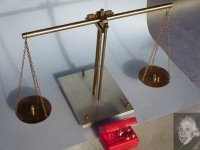Back in the early days of my hobby career I decided that building a balance scale would be a good skill-development project that might also yield a useful tool...
The three feet are all screw-adjustable so leveling it is easy. I bought a set of weights from a reputable laboratory supply company and with it proved that the scale is sensitive to differences as small as 100 milligrams. Modern electronic scales are much more sensitive but, remember, this was built to make me a better designer/machinist.
This photo shows the pivot and fine adjust mechanism. Analytical balances have pivots that consist of hardened knife edge blades resting on agate plates. Mine has brass on brass which creates more stiction but this is a shop tool meant to measure in the gram range. Loosening the topmost screw allows the horizontal bar to be slid back and forth to do the gross balancing. Then the knurled weights are adjusted on their screws to do the fine balancing. The sliding bar allows one to use pans that are not matched in weight.
One of my first uses of this scale was to verify an equation. I was writing my DIPSTICK program which calculates the calibration of dipsticks for tanks of various shapes. In some applications the tank is tilted slightly so that particulate matter in the fluid will collect in a section of the tank away from the output port. This nuance means that one must be able to calculate the volume of an ungula.
Aside:
If you put a small amount of water in a cylindrical glass and then tilt the glass so the water doesn't completely cover the bottom of the glass, the water takes on a shape that is called an ungula in mathematics. [This term derives from the fact that the shape resembles the hoof of a cow, which is ungula in Latin. In biology, the order Ungulata includes the hoofed animals.]
Some calisthenics in integral calculus and I had a formula but it was complex enough that I wanted to check my work. To do this I took an aluminum rod and machined an ungula from it. Taking measurements from it and entering them into my formula allowed me to calculate its volume.
From the same rod I machined a cylinder. Calculating its volume was trivial and, after weighing it, I could accurately compute the density of the material from which the ungula was made.
Weighing the ungula and dividing by the material density then yieled the true volume of the ungula which, to my relief, matched very well with the value calculated from my formula.
It's not likely you'll ever need to calculate the volume of an ungula but, should the need arise, there's a program on my site to do it.


 LinkBack URL
LinkBack URL About LinkBacks
About LinkBacks





 Reply With Quote
Reply With Quote



Bookmarks